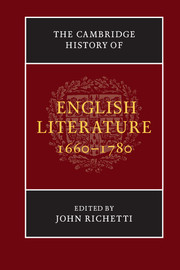Book contents
- Frontmatter
- Introduction
- PART I LITERARY PRODUCTION AND DISSEMINATION: CHANGING AUDIENCES AND EMERGING MEDIA
- 1 Publishing and bookselling 1660–1780
- 2 The social world of authorship 1660–1714
- 3 Popular entertainment and instruction, literary and dramatic: chapbooks, advice books, almanacs, ballads, farces, pantomimes, prints and shows
- 4 Novels on the market
- PART II LITERARY GENRES: ADAPTATION AND REFORMATION
- PART III LITERATURE AND INTELLECTUAL LIFE: THE PRODUCTION AND TRANSMISSION OF CULTURE
- PART IV LITERATURE AND SOCIAL AND INSTITUTIONAL CHANGE
- PART V LITERARY GENRES: TRANSFORMATION AND NEW FORMS OF EXPRESSIVENESS
- PART VI CONCLUSION
- Chronology
- Bibliographies
- Index
- References
3 - Popular entertainment and instruction, literary and dramatic: chapbooks, advice books, almanacs, ballads, farces, pantomimes, prints and shows
from PART I - LITERARY PRODUCTION AND DISSEMINATION: CHANGING AUDIENCES AND EMERGING MEDIA
Published online by Cambridge University Press: 28 March 2008
- Frontmatter
- Introduction
- PART I LITERARY PRODUCTION AND DISSEMINATION: CHANGING AUDIENCES AND EMERGING MEDIA
- 1 Publishing and bookselling 1660–1780
- 2 The social world of authorship 1660–1714
- 3 Popular entertainment and instruction, literary and dramatic: chapbooks, advice books, almanacs, ballads, farces, pantomimes, prints and shows
- 4 Novels on the market
- PART II LITERARY GENRES: ADAPTATION AND REFORMATION
- PART III LITERATURE AND INTELLECTUAL LIFE: THE PRODUCTION AND TRANSMISSION OF CULTURE
- PART IV LITERATURE AND SOCIAL AND INSTITUTIONAL CHANGE
- PART V LITERARY GENRES: TRANSFORMATION AND NEW FORMS OF EXPRESSIVENESS
- PART VI CONCLUSION
- Chronology
- Bibliographies
- Index
- References
Summary
At the chaotic intersection of English popular and print cultures stands Hogarth's magnificent female hawker, anchoring The Idle 'Prentice Executed at Tyburn (1747), the eleventh plate of a didactic moral history engraved in a consciously unpolished style and priced to appeal to an apprentice class at the crossroads of virtue and pleasure:
The Effects of Industry & Idleness Exemplified in the Conduct of two fellow prentices in twelve points Where calculated for the use & instruction of those young people wherein every thing nescessary to be convey'd to them is fully described in words as well as figure … [E]very thing necessary to be known was to be made as inteligible as possible and as fine engraving was not necessary to the main design provided that which is infinitely more material viz the characters and Expressions were well preservend, the purchase of them became within the reach of those for whom they [were] cheifly intended.
In this description, written in 1763, Hogarth fairly sums up the complex of instruction, entertainment, ostensible simplicity and affordable prices that had characterised the production and marketing of popular literature and drama for the previous hundred years. Of course, simplicity of intention in no way guaranteed simplicity of result, and in the hawker and her surroundings we find the abundant paradoxes linking official or commercial productions and popular responses to them: a legal demonstration of terror and control results in a chaotic festival fuelled by irreverence and gin; a printed ‘Last Dying Speech’ makes a marketable celebrity of a condemned man who has yet to speak; a ragged, dirty female carrying a child at the periphery of the crowd becomes a central symbol for popular print culture as she cries a minatory publication she probably cannot read to a socially mixed audience who will buy it more for entertainment than instruction.
- Type
- Chapter
- Information
- The Cambridge History of English Literature, 1660–1780 , pp. 61 - 86Publisher: Cambridge University PressPrint publication year: 2005
References
- 3
- Cited by

